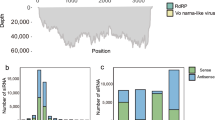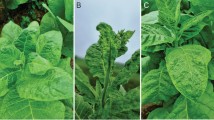Abstract
The whole genome sequence of a begomovirus (family Geminiviridae) infecting Muntingia calabura L. (family Muntingiaceae) from the province of Guayas in Ecuador was determined in this work. The major symptom observed on this plant species was yellow spots on leaves. The nucleotide sequences of three DNA-A clones and one DNA-B clone were compared to those of other begomoviruses. The DNA-A clones displayed the highest similarity to isolates of pepper leafroll virus (PepLRV), with 87.4 to 88.1% sequence identity. Likewise, the DNA-B clone showed the highest similarity (79.3-79.6% sequence identity) to PepLRV isolates. According to the demarcation criteria for begomovirus species, the begomovirus described in this work, for which we propose the name "muntingia yellow spot virus", represents a novel species. To our best knowledge, this is the first report of a begomovirus infecting a plant of the family Muntingiaceae.


Similar content being viewed by others
References
Zerbini FM, Briddon RW, Idris A et al (2017) ICTV virus taxonomy profile: geminiviridae. J Gen Virol 98:131–133. https://doi.org/10.1099/jgv.0.000738
Gilbertson RL, Batuman O, Webster CG, Adkins S (2015) Role of the insect supervectors Bemisia tabaci and Frankliniella occidentalis in the emergence and global spread of plant viruses. Annu Rev Virol 2:67–93. https://doi.org/10.1146/annurev-virology-031413-085410
Bayer C, Chase MW, Fay MF (1998) Muntingiaceae, a new family of dicotyledons with malvalean affinities. Taxon 47:37–42. https://doi.org/10.2307/1224016
Bayer C (2003) Muntingiaceae. In: Kubitzki K, Bayer C (eds) Flowering Plants ·Dicotyledons: malvales, capparales and non-betalain caryophyllales. Springer, Berlin, pp 315–319
Sarojini S, Mounika B (2018) Muntingia Calabura (Jamaica Cherry): an overview. PharmaTutor 6:1. https://doi.org/10.29161/pt.v6.i11.2018.1
Aguirre Z (2012) Especie forestales de los bosques secos del Ecuador. Guía dendrológica para su identificación y caracterización. Proyecto Manejo Forestal Sostenible ante el Cambio Climático. MAE/FAO. Finlandia-Quito, Ecuador 140p
Rojas MR, Gilbertson RL, Russell DR, Maxwell DP (1993) Use of degenerate primers in the polymerase chain reaction to detect whitefly-transmitted geminiviruses. Plant Dis 77:340–347
Edgar RC (2004) MUSCLE: multiple sequence alignment with high accuracy and high throughput. Nucleic Acids Res 32:1792–1797. https://doi.org/10.1093/nar/gkh340
Muhire BM, Varsani A, Martin DP (2014) SDT: a virus classification tool based on pairwise sequence alignment and identity calculation. PLoS ONE. https://doi.org/10.1371/journal.pone.0108277
Tamura K, Stecher G, Peterson D et al (2013) MEGA6: molecular evolutionary genetics analysis version 6.0. Mol Biol Evol 30:2725–2729. https://doi.org/10.1093/molbev/mst197
Martin DP, Murrell B, Golden M et al (2015) RDP4: detection and analysis of recombination patterns in virus genomes. Virus Evol 1:1–5. https://doi.org/10.1093/ve/vev003
Lole KS, Bollinger RC, Paranjape RS et al (1999) Full-length human immunodeficiency virus type 1 genomes from subtype C-infected seroconverters in India, with evidence of intersubtype recombination. J Virol 73:152–160. https://doi.org/10.1128/jvi.73.1.152-160.1999
Martínez-Ayala A, Sánchez-Campos S, Cáceres F et al (2014) Characterisation and genetic diversity of pepper leafroll virus, a new bipartite begomovirus infecting pepper, bean and tomato in Peru. Ann Appl Biol 164:62–72. https://doi.org/10.1111/aab.12074
Paz-Carrasco LC, Castillo-Urquiza GP, Lima ATM et al (2014) Begomovirus diversity in tomato crops and weeds in Ecuador and the detection of a recombinant isolate of rhynchosia golden mosaic Yucatan virus infecting tomato. Arch Virol 159:2127–2132. https://doi.org/10.1007/s00705-014-2046-y
Fiallo-Olivé E, Chirinos DT, Castro R, Navas-Castillo J (2018) First Report of Cabbage Leaf Curl Virus Infecting Common Bean, Cowpea, Pigeon Pea, and Mucuna pruriens in Ecuador. Plant Dis 102:2667. https://doi.org/10.1094/PDIS-05-18-0817-PDN
Argüello-Astorga GR, Ruiz-Medrano R (2001) An iteron-related domain is associated to Motif 1 in the replication proteins of geminiviruses: identification of potential interacting amino acid-base pairs by a comparative approach. Arch Virol 146:1465–1485. https://doi.org/10.1007/s007050170072
Brown JK, Zerbini FM, Navas-Castillo J et al (2015) Revision of Begomovirus taxonomy based on pairwise sequence comparisons. Arch Virol 160:1593–1619. https://doi.org/10.1007/s00705-015-2398-y
Briddon RW, Patil BL, Bagewadi B et al (2010) Distinct evolutionary histories of the DNA-A and DNA-B components of bipartite begomoviruses. BMC Evol Biol. https://doi.org/10.1186/1471-2148-10-97
Romay G, Chirinos DT, Geraud-Pouey F et al (2018) Complete genome sequence of two tomato-infecting begomoviruses in Venezuela: evidence of a putative novel species and a novel recombinant strain. Arch Virol 163:555–558. https://doi.org/10.1007/s00705-017-3611-y
Qadir R, Khan ZA, Monga D, Khan JA (2019) Diversity and recombination analysis of Cotton leaf curl Multan virus: A highly emerging begomovirus in northern India. BMC Genomics 20:1–13. https://doi.org/10.1186/s12864-019-5640-2
Díaz-Pendón JA, Sánchez-Campos S, Fortes IM, Moriones E (2019) Tomato yellow leaf curl sardinia virus, a begomovirus species evolving by mutation and recombination: a challenge for virus control. Viruses. https://doi.org/10.3390/v11010045
Paprotka T, Metzler V, Jeske H (2010) The first DNA 1-like α satellites in association with New World begomoviruses in natural infections. Virology 404:148–157. https://doi.org/10.1016/j.virol.2010.05.003
Bornancini VA, Irazoqui JM, Flores CR et al (2020) Reconstruction and characterization of full-length begomovirus and alphasatellite genomes infecting pepper through metagenomics. Viruses. https://doi.org/10.3390/v12020202
Acknowledgements
G.R. was the recipient of a Move-In Louvain postdoctoral fellowship from UCLouvain. This research was partially funded by a grant (no. PYTAUTO1639-2019-FIAG0002) of the Technical University of Manabí (UTM), Ecuador.
Author information
Authors and Affiliations
Corresponding author
Ethics declarations
Conflict of interest
The authors declare no conflict of interest.
Ethical approval
This article does not contain any studies with human participants or animals performed by any of the authors.
Additional information
Handling Editor: Robert H.A. Coutts.
Publisher's Note
Springer Nature remains neutral with regard to jurisdictional claims in published maps and institutional affiliations.
Supplementary Information
Below is the link to the electronic supplementary material.
705_2021_5039_MOESM2_ESM.docx
Supplementary file2 Table S1 Putative recombination events detected in DNA components of MuYSV by at least six methods included in the RDP4 software (DOCX 22 kb)
Rights and permissions
About this article
Cite this article
Romay, G., Chirinos, D.T., Castro, R. et al. Muntingia yellow spot virus: a novel New World begomovirus infecting Muntingia calabura L.. Arch Virol 166, 1759–1762 (2021). https://doi.org/10.1007/s00705-021-05039-5
Received:
Accepted:
Published:
Issue Date:
DOI: https://doi.org/10.1007/s00705-021-05039-5




